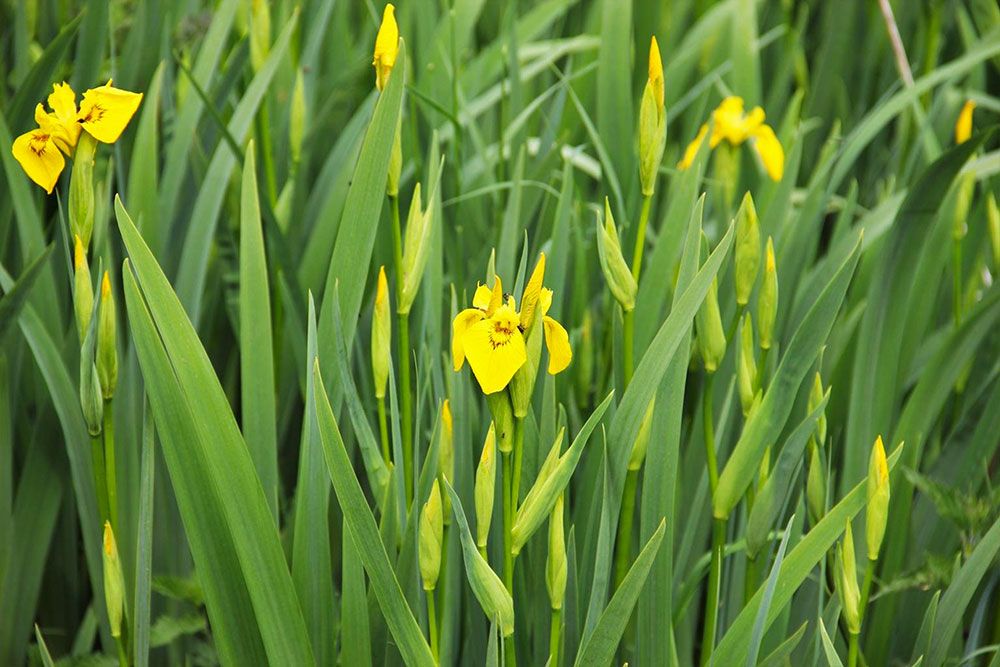Invasive Yellow Iris displaces native plants

Invasive Yellow Iris displaces native plants, makes wetlands drier
Invasive Plant of the Month Feature – Focus on Yellow Iris (Iris pseudacorus)
By Renee Sandelowsky and Helen Varekamp
Renee Sandelowsky and Helen Varekamp are Bayfield residents and local volunteers. They are writing a monthly series of articles, for the Canadian Coalition for Invasive Plant Regulation, about the benefits of planting native species of plants and removing invasive species. This month (May 2025), their focus is the invasive plant Yellow Iris (Iris pseudacorus).
You may be just one person, with one yard and one garden, but if you can eliminate invasive plant species in your yard, you’ve taken a giant step to help the ecosystem. If you can educate your neighbours about the dangers of invasive plants, you’ve taken another giant step to help wildlife, the environment, and the planet.
Invasive plants have little or no value for insects, birds or other wildlife. In fact, they cause harm. And invasive plants cause harm to our economy and to human health, as well.
Let’s educate people, just as we did with smoking and seat belts. Be patient with yourself and others. Take your time, focus on getting rid of one or two invasives and then replant with non-invasive plants. Also, replant with native plant species, to restore the health of your ecosystem and bring back pollinators and other wildlife.
Yellow Iris (Iris pseudacorus)
Yellow Iris is a perennial aquatic plant native to Europe, western Asia, and northern Africa. It was first introduced to North America in the 1800s as an ornamental plant for ponds and water gardens. The plant has since spread to many waterways, including those in parts of southern Ontario.
Yellow Iris can grow in both treed and open wetlands, along river and lake edges, and on flood plains. The plant spreads by seeds and by underground stems known as rhizomes that send out new shoots above the ground and roots below. These rhizomes can develop into thick mats, consisting of several hundred plants. Fragments of rhizomes, that break off, can also form new plants.
Impacts of Yellow Iris
- The dense stands of very thick mats of rhizomes and dead leaves can displace native plants and change wetlands to much drier environments.
- The drier environment reduces habitat available for wildlife, including native fish habitat and bird nesting and rearing sites.
- The dense mats can also block water flow in irrigation and flood control ditches.
- Yellow Iris is poisonous to both humans and animals if eaten, and its sap can cause dermatitis.
How to Manage Invasive Yellow Iris
Start with prevention. Yellow Iris is still sold in some nurseries. Do not buy or share this plant. Managing Yellow Iris is challenging but achievable with persistence and a multi-step approach:
- Manual Removal: Efforts are most likely to succeed when patches are small. Start by removing all flowers and seed heads to deplete the seed bank. Dig up and remove plants, including rhizomes, to control spread. Continue to monitor for re-growth as this process may take several years. Caution: all plant parts can cause skin irritation. Ensure gloves, safety glasses and long-sleeved clothing is worn during any work with this plant. Do not put plant material in the compost or municipal green waste.
- Smothering: Smothering or tarping is effective for populations growing on land or water. Start by cutting or mowing plants back, then cover with heavy PVC pond liner. Make sure you extend the liner at least one metre beyond the infestation and secure it. Monitor regularly for re-growth; remove the barrier when rhizomes have turned dark brown and mushy. Pond liner will likely need to be in place 4-6 months for success. Place all plant material in garbage for disposal.
- Herbicide Treatment: There is currently no chemical control available in Canada for Yellow Iris.
After removal, replant the area with regionally appropriate native plants. This step is essential to prevent reinfestation and to restore ecosystem health. Native plants will also attract pollinators and wildlife, improving biodiversity in your garden.
Alternatives
A good alternative choice, to plant, would be Cardinal Flower – Lobelia cardinalis
Learn More and Take Action
Education is key to combatting invasive plants. Learn to identify invasive species and choose native or non-invasive alternatives for your garden. Focus on managing one or two invasive plants at a time and be patient — successful eradication takes time and persistence.
To learn more, visit:
- Ontario Invasive Plant Council
- Canadian Coalition for Invasive Plant Regulation
- Grow Me Instead Guide
- Yellow Iris – Best Management Practices